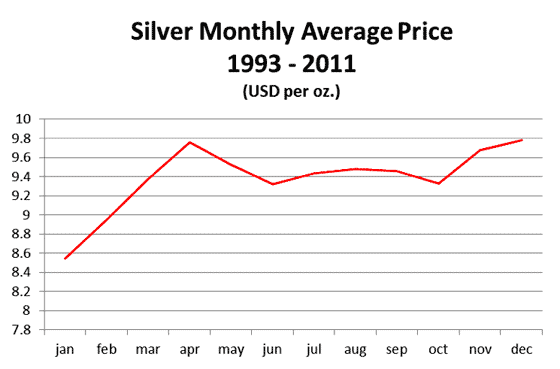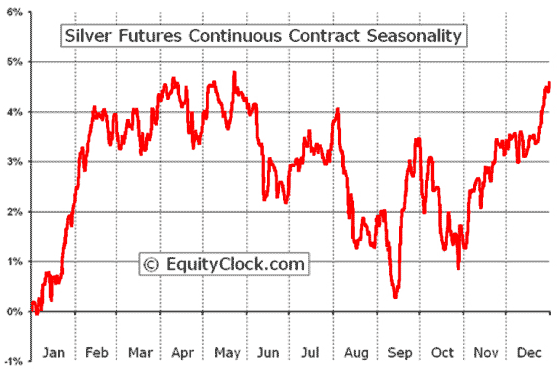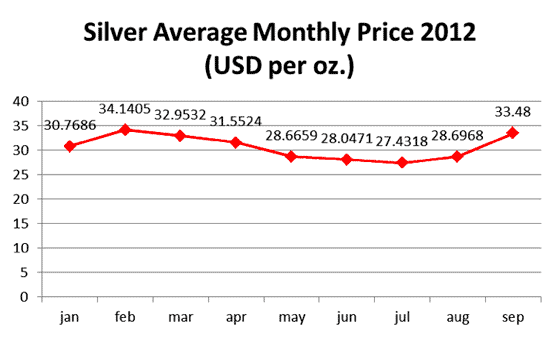Silvers Seasonal Price Swing
Commodities / Gold and Silver 2012 Oct 04, 2012 - 03:49 AM GMTBy: Anthony_David
 It’s that time of the year again when it makes perfect sense to invest in silver. Based on data compiled over the last 20 years, silver prices are known to peak during April-May and then again towards the end of the year. Between May and October, silver prices reach a low and then plateau out. The price of silver has grown from around USD 3.66 per ounce in early January 1993 to a high of USD 48.7 per ounce in April 2011—an amazing increase of 1230%.
It’s that time of the year again when it makes perfect sense to invest in silver. Based on data compiled over the last 20 years, silver prices are known to peak during April-May and then again towards the end of the year. Between May and October, silver prices reach a low and then plateau out. The price of silver has grown from around USD 3.66 per ounce in early January 1993 to a high of USD 48.7 per ounce in April 2011—an amazing increase of 1230%.

Silver prices normally follow gold prices and one can expect the seasonal rallies of silver to closely follow gold price rallies. It is pertinent however to note that in the last two decades, silver prices have seen more dramatic peaks and troughs when compared to the movement of gold prices. The reason for silver’s erratic price movements is that this metal has both investment and industrial demand often resulting in a conflict between the two. On the one hand the current industrial slowdown has impacted the price of silver, while on the other the price of silver is also driven by investment strategy, interest rates and the central banks’ moves to control inflation.

The chart in Fig. 2 was published by EquityClock.com and it shows the silver investment pattern over the last 20 years. The trend of buying silver in mid-September and selling in April-May in the last 10 years has yielded returns of about 33.78% .
Silver’s seasonal investment trend can be attributed to heightened buying spells during the Chinese New Year, Indian festivals of Akshaya Trithiya in April and Dhanteras in November, and to Christmas gifting and bullion coin releases for the New Year.

The charts (Fig. 3) for 2010 and 2011 show that silver made some of its most dramatic gains between September 2010 and April 2011. After the seasonal lows during May–July, silver prices rallied to levels of USD 42 per oz. during August–September 2011 before tapering off to lower levels at the end of the year. From September 2011 to March 2012 silver was actually down by 12.39%. One of the reasons for this poor performance was the major flood situation in Thailand which caused many of the country’s manufacturing facilities to be shut down. Thailand is the world’s largest manufacturer of electronic assemblies.

However, the recessional forces sweeping the US, the European debt crises and the general global economic depression haven’t dampened silver investment completely. Traditionally there’s more investment activity in gold, silver and precious metals during economic downturns. Industry pundits expect the demand for silver to reach new heights in Q4 of 2012 on the back of Thailand’s recovery from the flood disaster. There is also intense speculation that silver will outperform gold this year as the U.S. Federal Reserve and central banks across the world make stimulus moves to boost growth. This should get silver back on track to achieve the anticipated seasonal gains by April 2013.
Expect the industrial use of silver to grow in the coming years with the growth of green technologies and the mushrooming electronics industry. The industrial demand for silver could grow to levels that would seriously challenge the supply-demand balance which in turn could further impact the seasonal movement of silver prices.
By Anthony David
http://www.criticalstrategicmetals.com
The mission of the Critical Strategic Metals Web Siteis to serve as a monthly compass for those who take a fundamental view of investment regarding the Molybdenum, Manganese and Magnesium metals markets, are concerned with the emerging critical under-supply of these strategic metals to Western nations and wish to profitability chart their course. Each month we will research and provide, in as short and concise a manner as possible, the most applicable information available on resources that will have the biggest impact on our day to day lives. Click here to sign-up for our FREE monthly report.
© 2012 Copyright Anthony David- All Rights Reserved Disclaimer: The above is a matter of opinion provided for general information purposes only and is not intended as investment advice. Information and analysis above are derived from sources and utilising methods believed to be reliable, but we cannot accept responsibility for any losses you may incur as a result of this analysis. Individuals should consult with their personal financial advisors.
© 2005-2022 http://www.MarketOracle.co.uk - The Market Oracle is a FREE Daily Financial Markets Analysis & Forecasting online publication.



